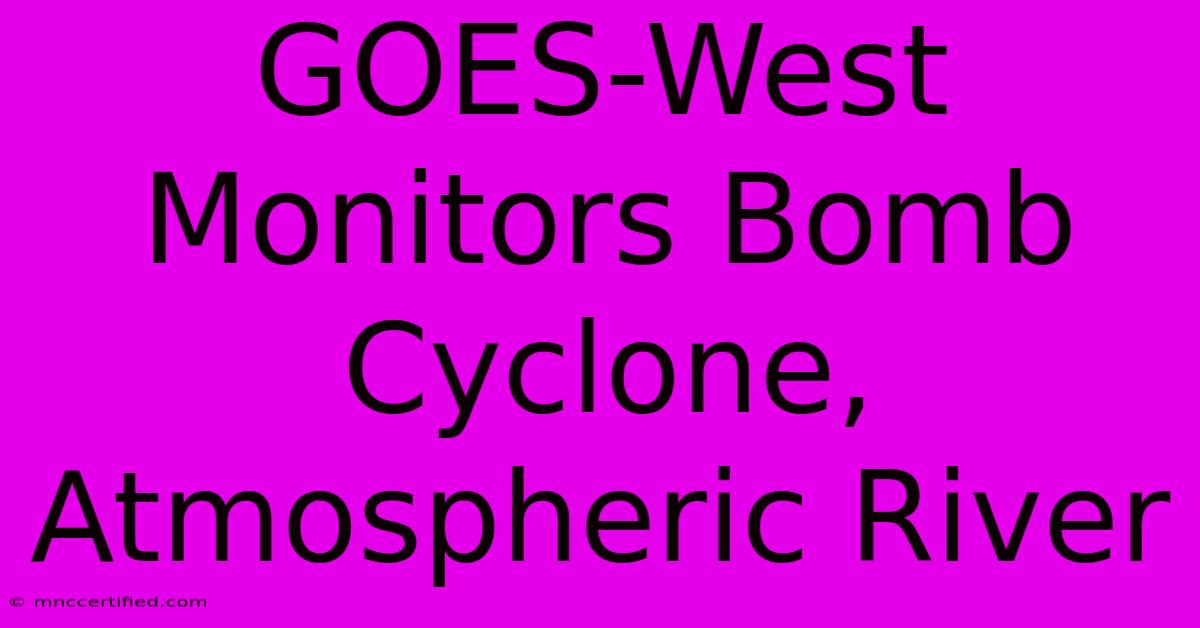GOES-West Monitors Bomb Cyclone, Atmospheric River

Table of Contents
GOES-West Monitors Bomb Cyclone, Atmospheric River: A Perfect Storm Brewing
The National Oceanic and Atmospheric Administration's (NOAA) GOES-West satellite is currently tracking a powerful weather system combining a bomb cyclone and an atmospheric river, posing significant risks across the western United States. This article delves into the specifics of this event, explaining the meteorological phenomena involved and highlighting the potential impacts.
Understanding the Dual Threat: Bomb Cyclone and Atmospheric River
This intense weather event is a dangerous combination of two significant meteorological phenomena:
What is a Bomb Cyclone?
A bomb cyclone, also known as a bombogenesis, is a mid-latitude cyclone that intensifies rapidly. This rapid intensification is defined by a pressure drop of at least 24 millibars in 24 hours. These storms are characterized by strong winds, heavy precipitation, and significant coastal flooding potential. The rapid pressure drop fuels the storm's intensity, leading to more extreme weather conditions. GOES-West provides crucial imagery to track the cyclone's development and movement.
What is an Atmospheric River?
An atmospheric river (AR) is a long, narrow, and transient corridor or filament of concentrated water vapor transport in the lower atmosphere. Think of it as a river in the sky. These rivers carry immense amounts of water vapor, which, upon encountering land, can lead to significant rainfall and flooding. When an AR combines with a bomb cyclone, the result is a potent and dangerous weather system, as the cyclone enhances the AR's precipitation potential.
The Synergy of Destruction: Bomb Cyclone + Atmospheric River
The confluence of a bomb cyclone and an atmospheric river creates a particularly hazardous situation. The bomb cyclone's powerful winds enhance the atmospheric river's precipitation, leading to significantly heavier rainfall than either event would produce individually. This increased precipitation dramatically raises the risk of:
- Flash flooding: Rapidly rising water levels in low-lying areas and urban streets.
- River flooding: Overflowing rivers and streams, potentially causing widespread damage and displacement.
- Landslides: Saturated soil destabilizes slopes, leading to potential landslides, especially in mountainous regions.
- High winds: The strong winds associated with the bomb cyclone can cause significant damage to property and infrastructure.
- Coastal erosion: Storm surges driven by the bomb cyclone can accelerate coastal erosion, threatening beachfront properties and infrastructure.
GOES-West's Crucial Role in Monitoring and Forecasting
The Geostationary Operational Environmental Satellite - West (GOES-West) plays a critical role in monitoring this dangerous weather system. Its high-resolution imagery and frequent data updates allow meteorologists to:
- Track the storm's movement and intensity: Providing crucial information for issuing timely warnings and advisories.
- Monitor precipitation rates: Assessing the potential for flooding and other hazards.
- Observe cloud cover and wind patterns: Gaining a comprehensive understanding of the storm's structure and evolution.
- Improve forecast accuracy: Leading to better preparedness and mitigation efforts.
GOES-West's data is crucial for public safety, allowing emergency management agencies to prepare for and respond to the impacts of this powerful storm.
Staying Safe During a Bomb Cyclone and Atmospheric River Event
If you live in an area affected by this combined weather event, it's crucial to take precautions:
- Stay informed: Monitor weather reports and advisories from NOAA and your local authorities.
- Prepare for power outages: Stock up on food, water, and essential supplies.
- Avoid unnecessary travel: Stay off the roads if conditions are hazardous.
- Heed evacuation orders: If instructed to evacuate, do so immediately.
- Know your risk: Understand the potential hazards specific to your area.
The combination of a bomb cyclone and an atmospheric river represents a serious weather threat. Thanks to satellites like GOES-West, we have the tools to monitor and predict these events, enabling effective preparation and mitigation strategies to minimize the risks and protect lives and property. Stay safe, stay informed, and be prepared.

Thank you for visiting our website wich cover about GOES-West Monitors Bomb Cyclone, Atmospheric River. We hope the information provided has been useful to you. Feel free to contact us if you have any questions or need further assistance. See you next time and dont miss to bookmark.
Featured Posts
-
Bondo Wood Filler Vs Body Filler
Nov 21, 2024
-
Obituary John Prescott 86 Dies
Nov 21, 2024
-
Insurance Companies Kingsport Tn
Nov 21, 2024
-
Watch Cavaliers Vs Pelicans Nba Game
Nov 21, 2024
-
How Much Are Pokemon Coins Worth
Nov 21, 2024